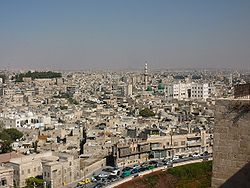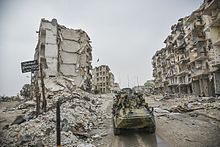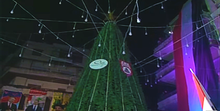Aleppo
|
حلب/ Halab Aleppo |
||
|---|---|---|
|
|
||
| coordinates | 36° 12′ N , 37° 9′ E | |
| basic data | ||
| Country | Syria | |
| Aleppo | ||
| ISO 3166-2 | SY-HL | |
| height | 390 m | |
| resident | 2,100,000 (2011) | |
| politics | ||
| governor | Marwan Olabi | |
|
View of Aleppo from the citadel (2009).
|
||
Aleppo ( Arabic حلب, DMG Halab ; French Alep ; Kurdish ( Kurmanji ) Heleb ; Turkish Halep ; Armenian Հալէպ ; Aramaic 회다 Halab ; in ancient times at times Beroia ) is a city in northern Syria . Aleppo is also the capital of the Aleppo Governorate of the same name . In 2006, Aleppo became the first place after Mecca to be named the Capital of Islamic Culture .
The city had just under 1.7 million residents in the city limits in 2008 and around 2.5 million residents with suburbs in 2010. It was the second largest city in Syria after Damascus . Also, Aleppo is one of the oldest cities in the region and occupies a strategic point between the Mediterranean Sea and the Euphrates . Originally it was built on a ridge in a wide fertile valley on both sides of the Quwaiq River .
In the course of the civil war in Syria , the city of Aleppo was fought over from summer 2012 to December 2016. Since December 22, 2016, the city has been controlled by Syrian government troops. Large parts of the city have been destroyed and many of the residents fled. According to the UN and the International Organization for Migration (IOM), in the first 7 months after the Syrian army's victory, most of them have already returned.
population and religion
The Arab population makes up the majority of the Muslim population in Aleppo . There are also Kurds , Turkmens and other smaller Muslim ethnic groups.
About 15-20% of the inhabitants are Christians , mostly Assyrians and Armenians , they belong to the Syrian Orthodox or Armenian Orthodox Church, and there are also Greek Orthodox believers. A large proportion of Christians live in the al-Judaide district just north of the old city of Aleppo . Another Christian, younger district is Sulaymaniyah.
Surname
| Aleppo in hieroglyphs | |||||||
|---|---|---|---|---|---|---|---|
Chalba ẖrb3 Aleppo |
|||||||
place name
The Akkadian name of the city was Halab or Halap (also spelled Hallaba , Halba , Halbi , Halpa ), the Hittite Ḫalpa. In the Egyptian sources the city is called "Chalba", in Ugaritic and Aramaic Ḥlb , in antiquity it was known as "Halpa (Ḫalpa)", in Seleucid times it was called Beroea .
The Arabic form of the name "Halab" ( Turkish : Halep) can be interpreted as the past tense of " milk ". A legend connects the name with Abraham , who is said to have milked his cow ash-Shahba at this place and distributed the milk to the poor. When the poor people met, they asked each other "Halab Abraham?", which means something like "Did Abraham milk?". In the Syrian-Arabic language, the city is also called Halab al-Schahba .
personal names
Ḫalpa can also be part of the name, as with the chief scribe Ḫalpamuwa in Ḫattuša and the chief cupbearer Ḫalpaziti ( m Ḫal-pa-zi-ti ) under Arnuwanda , presumably this is a designation of origin. Also from Nuzi personal names are occupied with the element Ḫalpa. A seal impression of a certain Ḫalpa-nubar is known from Alalaḫ .
story
antiquity
At the end of the 19th century B.C. (according to the Middle Chronology ) Aleppo first appears in the sources. At that time it was the capital of the state of Jamchad , which grew from here until the second half of the 17th century BC. BC Northern Syria dominated. His sphere of influence included Carchemish on the Euphrates and Alalach near Antakya . The influence of the Jamchad kings Jarim Lim I and Hammurabi I , who reigned from the 1780s to the 1850s, extended into the Trans- Tigridian area of Der and an alliance with Hammurabi of Babylon is attested. Already in this period Aleppo was a center of worship of the weather god Hadad .
The city was conquered by the Hittite king Muršili I in the second half of the 17th century . Their history after the fall of the Althittite Empire is unclear. Mitanni subdued Aleppo no later than the beginning of the 15th century. The Hittite king Tudḫaliya I seems to have launched a campaign against Aleppo and briefly controlled the city. However, the city only became part of the Hittite Empire again in the second half of the 14th century under Šuppiluliuma I , and Telipinu was installed as king . This is mentioned on an architectural inscription walled into the southern wall of the Al-Qaiqan Mosque in the Al-Aqaba district. Aleppo was now the capital of the Hittite province of Ḫalpa. After the fall of the Hittite Empire around 1200, Aleppo became the seat of a late Hittite minor principality . This is indicated, for example, by orthostats excavated in the citadel of Aleppo (which unfortunately are not yet open to the public).
Later, Aleppo became the capital of the Aramaic kingdom of Bit Agusi , which also included Arpad (Tell Rifa'at). Salmānu-ašarēd III. (858-824 BC), the city was able to be incorporated into the Assyrian Empire and, like his predecessor Adad-nirari II (911-891), reached the Mediterranean Sea. From 610 a period of Persian rule followed. Since there are no records of Aleppo from the time of Assyrian and Persian rule, it is assumed that the settlement was relatively badly damaged, perhaps during the fall of the Hittite Empire, and was only restored by the conquests of Alexander and the formation of the Seleucid Empire. Alexander occupied Aleppo in 333 BC. 301-281 BC and Seleucus I Nicator established a Macedonian colony there, which was named Beroia . This fortified colony with a square floor plan received i.a. streets laid out at right angles and shaped the cityscape of Aleppo in its basic form, even for later times. Hadad continued to be worshiped as Zeus . In the year 100 BC Syria was conquered by the Armenian Empire and in 64 B.C. conquered by the Romans .
middle age

The city became part of the Byzantine Empire under its old name . In 540 it was conquered and plundered by the Sassanid king Chosrau I , and part of the population was kidnapped. The destruction was repaired by Justinian I before the city fell to the Arabs in 639 after a five-month siege. Under the Hamdanids (944–1003), Aleppo achieved some independence. The most important Hamdanid ruler was Saif ad-Daula (944–67). In 962 the city was recaptured and systematically plundered by the Byzantine emperor Nikephoros Phocas . It remained Byzantine until 976/77 and was then a Byzantine vassal until the Seljuk invasion. From 1025 the city was ruled by the Arab Mirdasids until it was taken by the Seljuks in 1070 .
The city was besieged by Crusaders in 1098 and 1124/25, but not conquered. Under 'Imad ad-Din Zengi (1127/28–46), a Turkmen from Mosul , Aleppo became the center of resistance against the Crusader states . His son Nur ad-Din (1146–74) restored the city's fortifications, which had been damaged by the devastating earthquake , and under his rule many important buildings were constructed. After the death of Nur ad-Din, Aleppo fell to the Ayyubid Sultan Saladin . The Ayyubid dynasty ruled the city from 1183 to 1260. Az-Zahir Ghazi (1186/93–1216), son of Saladin, renewed the fortifications of the citadel.
Aleppo remained in Ayyubid hands until, like much of northern Syria, it was conquered and devastated by the Mongols under Hulagu in 1260. From 1260 to 1516 the city was part of the Mamluk Empire. The citadel was rebuilt in 1292 but destroyed again by Timur around 1400 .
modern times
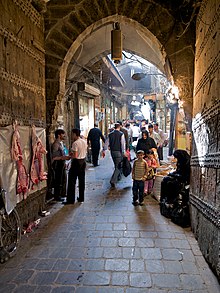
The battle of Marj Dabiq took place near Aleppo in 1516. In 1517 Aleppo became part of the Ottoman Empire . At that time the city had about 50,000 inhabitants. It was the seat of a provincial governor ( Beylerbey or Wali ). The city remained part of the Ottoman Empire until its fall, but it continued to be shaken by internal feuds , plague epidemics and, in 1823, cholera . In November 1850, the artillery officer Josef Bem , at the head of Turkish troops, crushed a pogrom by the Muslim population against the Christians. In 1901 the population of Aleppo was around 125,000.
During World War I, Aleppo was a center in the genocide of the Armenians by the Young Turks . On the orders of Talât Pasha , the Armenians were rounded up from May 27, 1915 and sent on death marches over impassable mountains in the direction of Aleppo.
The city flourished again briefly when it came under French colonial rule after the end of World War I , but experienced a decline again after the cession of the Sanjak of Alexandretta with the capital Antakya and the port of İskenderun to Turkey in 1939.
After 1945
In 1947 there were pogroms against the Jews in the city, in which up to 75 Jewish citizens died , the city's main synagogue was destroyed and the Codex of Aleppo from the 9th century was temporarily lost and is only in use today sharing has reappeared.
The city was essentially redesigned after the Second World War , which is why the old town and the new town differ significantly: Aleppo's old town ( medina ) was located within a five-kilometer-long city wall with seven gates and has an area of approx. 350 ha. In 1952, the French architect created Andre Gutton numerous new wide roads in the interests of modern traffic management. In the 1970s, large parts of the old town were demolished in favor of modern apartment blocks, and the old town became more and more dilapidated. According to the 2004 census, 118,000 people live in the old town.
World Heritage
In 1986 UNESCO declared Aleppo's old town a World Heritage Site . Since 1993 it has been renovated in cooperation with the GTZ and with the support of the Aga-Khan - Trust for Culture and the Arab Fund for social and economic development (10 million euros from the German-Syrian debt relief agreement). In 2004, the project received an Urban Design Award from the Harvard School of Design . The city has been on the Red List of World Heritage in Danger since 2013, along with all UNESCO World Heritage sites in Syria due to the civil war .
civil war
In the course of the civil war in Syria , fierce fighting broke out in Aleppo in July 2012. Rocket launchers, tanks, helicopters and fighter jets were used in these battles. In the night of September 28th to 29th, 2012, the historic bazaar was largely destroyed by a major fire. This bazaar is the world's largest covered old market district and is part of the UNESCO World Heritage. The large fire was apparently sparked by hostilities. A tank shell severely damaged the minaret of the 700-year-old Mahmandar Mosque. The nearly 500-year -old Chusrawiyya Mosque was destroyed in 2014. On July 27, 2016, pro-government troops said they managed to close the siege ring around neighborhoods still held by rebel groups. According to United Nations estimates as of July 31, 2016, around 300,000 people were trapped in urban areas of Aleppo that were under the control of some moderate and some Islamist rebel groups. An offer by the government and its Russian allies to leave the besieged part of the city under safe conduct was initially taken up by only a few people. Meanwhile, after three weeks of fighting, rebels broke the siege with reinforcements coming from the south-west on August 6th. The siege ring was closed again by government troops in early September. On December 22, the Syrian government announced it had defeated the insurgents in the city and completely occupied all parts of the city. A total of 34,000 insurgents and their families had been evacuated in buses from the rebel-held areas of Aleppo in the days prior to an agreement.
In December 2016, UNOSAT released an assessment of the extent of the destruction in Aleppo, based on analysis of September 2016 satellite imagery. This analysis assumes that more than 33,000 buildings in Aleppo were damaged. The analysis shows that about two-thirds of the damaged and destroyed buildings are in eastern Aleppo.
business
Historically, the city was primarily important as a trading center. It lay at the crossroads of two trade routes and mediated trade from India , the Euphrates and Tigris regions with Damascus to the south following the foot of the mountains rather than the impassable sea coast. Since the early Middle Ages, the handmade “ Aleppo soap ” has been made in Aleppo on the basis of olive oil and is not only appreciated and well-known in the Orient . The soap factories (sgl. maṣbana ) were located around the Bab Qinnasrin in the south-west of the old city, part of which is still there today. Other establishments moved to the streets at Bab an-Nasr to the north of the citadel. Due to the large space requirement, some soap factories have set up in former Hanen . Hane are lodgings and sales places for merchants that have existed within the Old Town since the early 16th century. Today there are still around 60 smaller soap factories in Aleppo, most of which are family businesses and have often been around for many centuries.
In the Middle Ages, the Zengids and the Ayyubids (1128-1260) in particular made the city a center of long-distance trade. The Ayyubids concluded trade treaties with Venice in 1207/1208, 1225, 1229 and 1254/1255 . In Ottoman times there were trading posts and trading posts not only from Venice, but also from French (1535), English (1580) and Dutch (1612) merchants. Although trade was often banned from the city for political reasons, it grew steadily until the Europeans took the sea route to India around the Cape of Good Hope and the route to Egypt via the Red Sea . This began the city's economic decline; their main exports are now agricultural produce of the region, mainly wheat and cotton , pistachios , sheep and olives .
traffic
In 1906 Aleppo was connected to Damascus by the Hejaz railway, and in 1912 to Istanbul and Baghdad via the Baghdad railway . The city also has an international airport .
education
In 1958, the Aleppo State University was founded, with over 60,000 students enrolled before the civil war. A Jewish study hall (Beth Midrash) had the Aleppo main synagogue .
Attractions
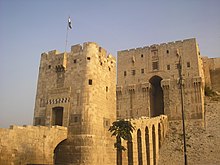

The medieval citadel lies on a partly artificially built settlement hill ( tell ) 50 m above the city ( 36° 11′ 57″ N , 37° 9′ 45″ E ). The current structure was built in the 13th century after Timur destroyed an earlier structure, but it was damaged by an earthquake in 1822. Predecessor buildings are already known from Seleucid times. In the center of the citadel is the Temple of the Weather God of Aleppo, overlaid by many subsequent buildings. dates back to The Hamdanide Saif ad-Daula had it expanded in the 10th century.
The best-known mosque is the Great Umayyad Mosque on the northern edge of the covered souk . It was started by the Umayyads ; the surviving building by the Zengid Nur ad-Din dates from 1158, the reconstruction after the Mongol invasion from 1260. The original mosque partially included an early Byzantine cathedral from the end of the 5th century in the building. This might itself have been built on top of an older temple . The church was dedicated to Helena , the mother of Constantine I. According to tradition, the tomb of the father John the Baptist lay here . Adjacent to the west is the Madrasa al-Halawiya , an Islamic college founded by Nur ad-Din in the 12th century. The wood carvings of the mihrab are inscribed with a date of 1245. A work by the Ottoman architect Sinan , among others, is the Adliye Mosque .
The clock tower designed by French engineer Charles Chartier is located at the historic entrance to the city of Bab al-Faraj . Aleppo also houses the National Museum with numerous archaeological finds and - as a traditional trading center - souks and trading yards ( hane ).
The Armenian Apostolic Cathedral of the Forty Martyrs was built in 1429, the Armenian Catholic Churches of the Holy Trinity and Holy Cross in 1965 and 1993.
archeology
From 1996 to 2005, a team from the Berlin University of Applied Sciences under the direction of Kay Kohlmeyer carried out archaeological excavations in the area of the citadel of Aleppo. The aim of the excavations was to uncover the temple of the weather gods in Aleppo. This was in the 2nd and early 1st millennium BC. one of the most important gods of the region, who was also worshiped in the Hittite area . Most of the cult room was uncovered from the temple. The plinth zone of the inner walls and the plinth of a wide pedestal in front of the cult niche were decorated with a frieze of stone reliefs. Various gods and hybrid creatures are shown here. Two particularly highlighted reliefs depict a king Taitas (probably 11th century BC) and the weather god of Aleppo standing opposite him.
Numerous seals from the late Old Syrian Period I (around 1800 BC) suggest that Aleppo was the seat of important stone cutting workshops.
Findings from Gabbul suggest that Aleppo was the seat of a school of sculpture in the Middle Syrian period (1600–1200 BC). Two basalt lions have been found on the citadel, believed to be from a late Hittite gate or temple of the 10th century BC. come from. The statue of the prince at 'Ain et-Tell (Arpad) is also dated around 800 BC. in Aleppo.
sons and daughters of the town
- Mariam al-Asturlabi (10th c.), astrologer in the court of Saif ad-Daula
- Ibn al-Adim (1192/1193–1262), judge and local historian
- Philipp Stamma (around 1705–1755), important chess player of the 18th century
- Boghos Sabbaghian (1836–1915), Patriarch of Cilicia of the Armenian Catholic Church
- Maximos IV Sayegh (1878–1967), Melkite Archbishop and Patriarch of Antioch
- Mahmut Kamil Pasha (1880–1922), Ottoman general
- Ezra Atya (1881/1885–1970), Israeli ultra-Orthodox rabbi
- Isidore Fattal (1886–1961), Melkite Archbishop of Aleppo
- Krikor Hindié (1891–1967), Armenian Catholic Archbishop of Aleppo
- Justin Abraham Najmy (1898–1968), Melkite Bishop of Newton
- François Ayoub (1899–1966), Archbishop of the Syrian Maronite Church
- Émile Benveniste (1902–1976), French Indo-European scholar
- Joseph Basmadian (1920–1988), Armenian Catholic Archbishop of Aleppo
- Néophytos Edelby (1920–1995), Melkite Archbishop of Aleppo
- Elias Nijmé (1920–1998), Melkite Archbishop of Tripoli
- Michel Yatim (1920–2006), Melkite Archbishop
- Hilarion Capucci (1922–2017), Greek Catholic theologian, Auxiliary Bishop of the Melkite Patriarchate of Antioch and political activist
- Georges Layek (1922–1983), Armenian Catholic Archbishop of Aleppo
- Boutros Raï (1922–1994), Bishop of the Melkite Greek Catholic Church of Mexico
- Elias Farah (1927–2013), Arab Ba'athist ideologue
- Ignatius Pierre VIII Abdel-Ahad (1930–2018), Syriac Catholic Archbishop of Beirut and Patriarch of the Rome-united Syriac Catholic Church of Antioch
- François Rabbath (born 1931), French composer and double bass player of Syrian origin
- Emmanuel Dabbaghian (1933–2018), Armenian Catholic Archbishop of Baghdad
- Sabah Fakhri (1933–2021), Arab classical music singer
- Krikor Bedros XX. Ghabroyan (1934–2021), Armenian Catholic Patriarch
- Dia Succari (1938–2010), French composer and music teacher of Syrian origin
- Zuhair Mashariqa (1938–2007), Syrian Vice President
- Georges Kahhalé Zouhaïraty (born 1938), Apostolic Exarch for the Melkite Greek Catholic Church in Venezuela
- Abdulghafur Sabuni (born 1940), Arabic scholar and university lecturer
- Jean-Clément Jeanbart (born 1943), Archbishop of the Melkite Greek Catholic Church of Aleppo
- Nikolaki Sawaf (born 1943), Melkite Archbishop of Latakia
- Muhammad Naji al-Utri (born 1944), Prime Minister of Syria (2003–2011)
- Levon Ter-Petrosyan (born 1945), first President of Armenia (1991–1998)
- Niroz Malek (born 1946), writer and painter
- Michel Abrass (born 1948), Melkite Archbishop
- Boutros Marayati (born 1948), Armenian Catholic Archbishop of Aleppo
- Isidore Battikha (born 1950), Melkite Archbishop of Homs
- Elie Yéghiayan (born 1950), Armenian Catholic Bishop of Paris
- Muhammed Achmed Faris (born 1951), Syrian Air Force pilot, first and only Syrian in space
- Krikor-Okosdinos Coussa (born 1953), Armenian Catholic Bishop of Iskanderiya in Egypt
- Vartan Oskanyan (born 1955), Armenian politician and Minister of Foreign Affairs of the Republic of Armenia (1998–2008)
- Mayada El Hennawy (born 1959), singer
- Georges Khawam (born 1959), Melkite Greek Catholic Archbishop of Latakia
- Joseph Khawam (born 1968), Melkite Greek Catholic Exarch of Venezuela
- Georges Masri (born 1968), Melkite Greek Catholic Archbishop of Aleppo
- Nersès Zabbara (born 1969), Armenian Catholic Apostolic Administrator of Baghdad
- Fadwa Soliman (1970–2017), actress
- Joseph Tobji (born 1971), Maronite Archbishop of Aleppo
- Houry Dora Apartian (born 1976), jazz singer
- Imad Mardnli (born 1976), actor
- Nazir Jaser (born 1989), cyclist
- Ghofrane Mohamed (born 1989), track and field athlete
List of rulers of Aleppo
- Wantarassura from Aleppo, contemporaneous with Sauštatar from Mitanni and Niqmepa from Alalach
- Yarim Lim I
- Hammurabi I
Seljuk dynasty in Aleppo and Damascus :
- Aq Sunqur al-Hajjib , governor of Aleppo and Damascus until 1094
- Tutush I , Sultan of Aleppo and Damascus 1094–1095
Seljuk dynasty in Aleppo :
- Rodwan ibn Tutush (1095–1113)
Ayyubid emirs of Aleppo :
- al-Adil I (1183–1186)
- az-Zahir Ghazi (1186–1216)
- al-Aziz (1216–1236)
- an-Nasir Yusuf (1236–1260)
various
The city became the namesake of the Aleppo pine ( Pinus halepensis ), a conifer native to the eastern Mediterranean . Aleppo bubo , a form of leishmaniasis , is also named after the city.
climate table
| Aleppo | ||||||||||||||||||||||||||||||||||||||||||||||||
|---|---|---|---|---|---|---|---|---|---|---|---|---|---|---|---|---|---|---|---|---|---|---|---|---|---|---|---|---|---|---|---|---|---|---|---|---|---|---|---|---|---|---|---|---|---|---|---|---|
| climate diagram | ||||||||||||||||||||||||||||||||||||||||||||||||
| ||||||||||||||||||||||||||||||||||||||||||||||||
|
Monthly average temperatures and rainfall for Aleppo
Source:
|
|||||||||||||||||||||||||||||||||||||||||||||||||||||||||||||||||||||||||||||||||||||||||||||||||||||||||||||||||||||||||||||||||||||||||||||||||||||||||||||||||||||
literature
- Peter Bamm : Early Sites of Christianity . Kösel, Munich 1960, p. 167 ff.
- Joan Busquets (ed.): Aleppo: Rehabilitation of the Old City. Harvard University, Graduate School of Design, Cambridge Mass./London 2005, ISBN 978-0-935617-84-9 .
- Mamoun Fansa , Heinz Gaube , Jens Windelberg: Damascus - Aleppo. 5000 years of urban development in Syria. von Zabern, Mainz 2000, ISBN 3-8053-2694-7 .
- Mamoun Fansa (ed.): Aleppo. A war destroys world cultural heritage. History, Present, Perspectives. Nünnerich-Asmus, Mainz 2013, ISBN 978-3-943904-25-3 .
- Anette Gangler: A traditional residential area in the northeast of the old city of Aleppo in northern Syria. Wasmuth, Tübingen/Berlin 1993, ISBN 3-8030-0158-7 .
- Anette Gangler, Meinolf Spiekermann: Madīnatī Halab - My Aleppo. Media combination with Arabic texts. Edition Esefeld & Traub, Stuttgart 2011, ISBN 978-3-9809887-6-6 . Including 1 CD.
- Heinz Gaube, Eugen Wirth: Aleppo. Historical and geographical contributions to the structural design, social organization and economic dynamics of a Near Eastern trading metropolis. Reichert, Wiesbaden 1984, ISBN 3-88226-193-5 .
- Mariam de Ghantuz Cubbe: I Maroniti d'Aleppo nel XVII secolo attraverso i racconti dei missionari europei. Jaca Book, Milano 1996, ISBN 88-16-40412-4 .
- Julia Gonnella , Wahid Khayyata, Kay Kohlmeyer : The Aleppo Citadel and the Temple of the Weather God. New research and discoveries. Rhema, Munster 2005, ISBN 978-3-930454-44-0 .
- Julia Gonnella: The Citadel of Aleppo. In: EJOS. IV (2001), ISSN 0928-6802 .
- Abdallah Hadjar: Historical Monuments of Aleppo. Automobile and Touring Club of Syria, Aleppo 2000.
- Kay Kohlmeyer : The Temple of the Weather God of Aleppo. Building history and building type, spatial references, inventory and pictorial equipment. In: Temple Building and Temple Cult: Architecture and Cultic Paraphernalia of Temples in the Levant (2nd-1st millennium BCE). Harrassowitz, Wiesbaden 2012, ISBN 978-3-447-06784-3 .
- M. Soubhi Saouaf: Le Musée d'Alep. Aleppo 1968.
movies
- For Sama , British-Syrian documentary film directed by Waad al-Kateab and Edward Watts (2019)
- The Last Men of Aleppo , Syrian documentary by Feras Fayyad (2017)
- The Fate of the Children of Aleppo , documentary short film by Marcel Mettelsiefen (2016)
See also
web links
- Aleppo. A poem in a stone, gray by day and gold by night. sahab-travel.com ( Memento of October 25, 2013 at the Internet Archive )
- University of Aleppo (English) ( Memento of October 24, 2007 at the Internet Archive )
- Friends of the Old City of Aleppo e. V
itemizations
- ↑ http://www.sos-kinderdoerfer.de/unsere-arbeit/wo-wir-helfen/asien/syrien/aleppo
- ↑ https://web.archive.org/web/20161222194329/http://www.tagesschau.de/ausland/aleppo-705.html
- ^ United Nations News Service Section: UN News - Over 600,000 displaced Syrians returned home so far this year - UN agency. 11 August 2017, retrieved 12 September 2017 (English).
- ↑ Over 600,000 Displaced Syrians Returned Home in First 7 Months of 2017 . In: International Organization for Migration . 11 August 2017 ( iom.int [accessed 12 September 2017]).
- ↑ Kurds. Retrieved 6 June 2019 (British English).
- ↑ Annelies Kammenhuber : The Aryans in the Near East . Carl Winter Universitätsverlag, Munich 1968, p. 76.
- ↑ From Luwish ziti = man, see Erich Ebeling , Bruno Meissner , Dietz-Otto Edzard (eds.): Ḫalpaziti . In: Reallexikon der Assyriologie and Near Eastern Archaeology . de Gruyter, Berlin 1981, p. 69.
- ↑ Heinrich Otten (ed.): Hittite and other Anatolian and Near Eastern Studies in Honor of Sedat Alp . p. 414.
- ↑ David I. Owen, Gernot Wilhelm (eds.): General studies and excavations at Nuzi. CDL Press, Bethesda 1998 ( Studies on the civilization and culture of Nuzi and the Hurrians Vol. 10/2), p. 126.
- ↑ Dominique Collon: The seal impressions from Tell Atchana/Alalakh . 1975
- ↑ H. Th. Bossert: Remarks on a hieroglyphic Hittite inscription from Aleppo . In: Syria . tape 31 , no. 3 , ISSN 0039-7946 , p. 225-253 .
- ↑ Cf. J. Sauvaget: Art. Halab , in: The Encyclopaedia of Islam. New Edition Vol. 3 (1971), pp. 85–90, here 85.
- ↑ Russia: No asylum for Assad. In: Frankfurter Rundschau . September 22, 2012, retrieved October 22, 2012 .
- ↑ UNESCO calls destruction in Aleppo tragedy. In: The Mirror . 30 September 2012, retrieved 22 October 2012 .
- ↑ Syria's cultural treasures under threat. In: The Mirror . 1 October 2012, retrieved 22 October 2012 .
- ↑ Battlefield Culture: How Syria's World Heritage Sites Are Being Destroyed. In: ttt – title, theses, temperaments . October 21, 2012, retrieved October 22, 2012 .
- ↑ Reuters, "Aleppo: Russia plans to set up evacuation corridors for civilians" ( Memento of 28 July 2016 at the Internet Archive ), in: Der Standard , 28 July 2016.
- ↑ Michael Lüders in conversation with Thielko Grieß: "Islamists set the tone in Aleppo" , Deutschlandfunk , August 1, 2016.
- ↑ AP: "Syrian Rebels Launch Push Aimed at Breaking Aleppo Siege" ( Memento of July 31, 2016 at archive.today web archive ) New York Times of July 31, 2016
- ↑ Siege of Aleppo: Syrian rebels announce breakthrough. FAZ.NET , August 6, 2016, retrieved August 7, 2016 .
- ↑ dpa: "Regime troops again encircle rebels in Aleppo" NZZ of September 4, 2016
- ↑ "Syrian army say they have retaken Aleppo" The Independent 22 December 2016
- ↑ Analysis of the destruction in Aleppo. UNITAR-UNOSAT 20 December 2016, accessed 22 January 2017 .
- ↑ Gaube / Wirth 1984, p. 152 f
- ↑ Aleppo bump. In: Meyer's Large Conversational Lexicon . 6th edition. Volume 1, Bibliographic Institute, Leipzig/Vienna 1905, p. 291 .
- ↑ WMO
- ↑ wetterkontor.de

